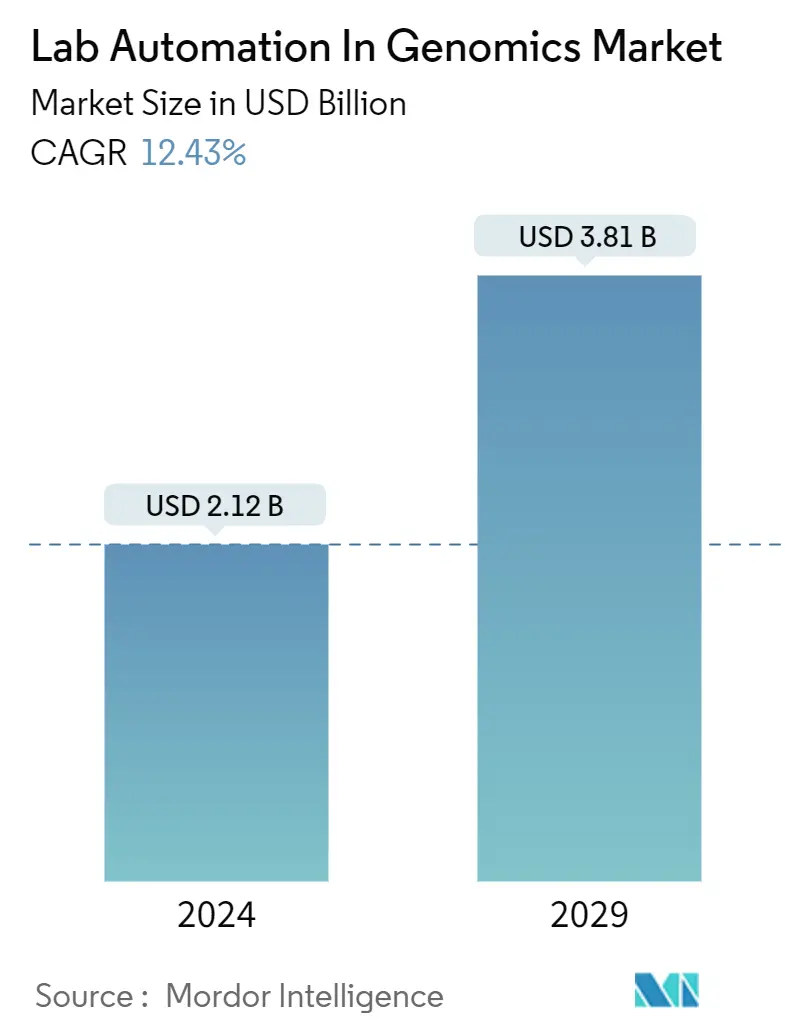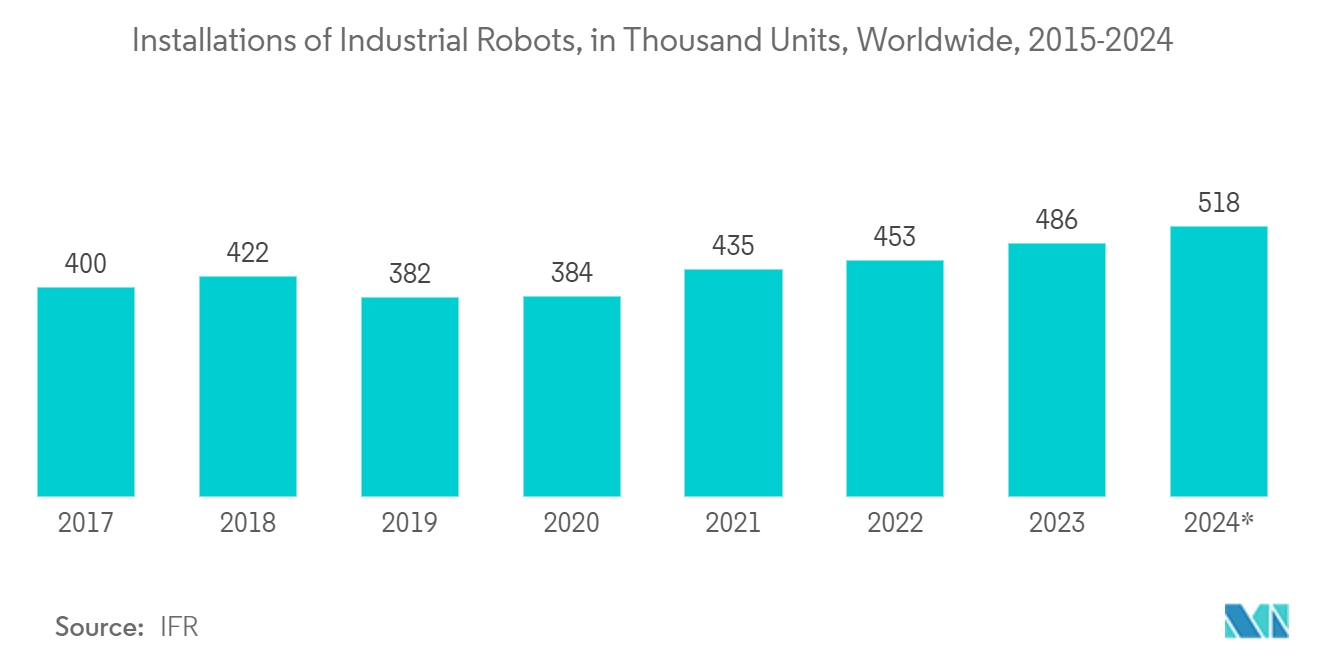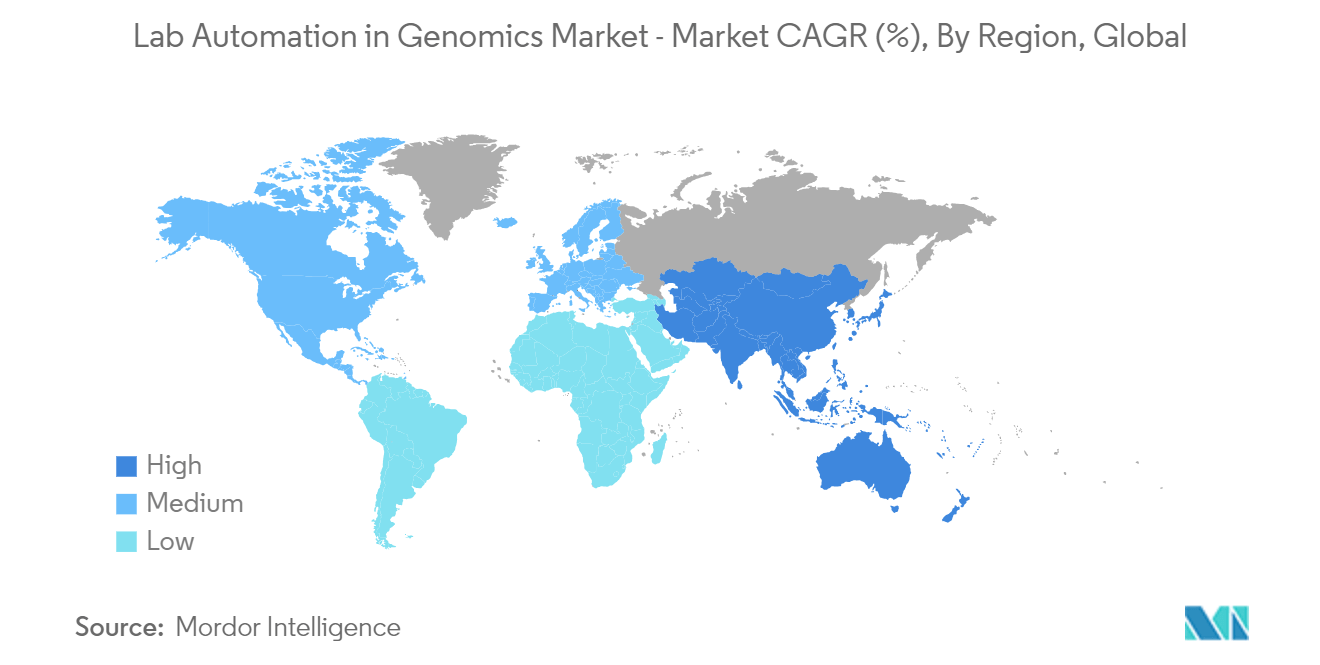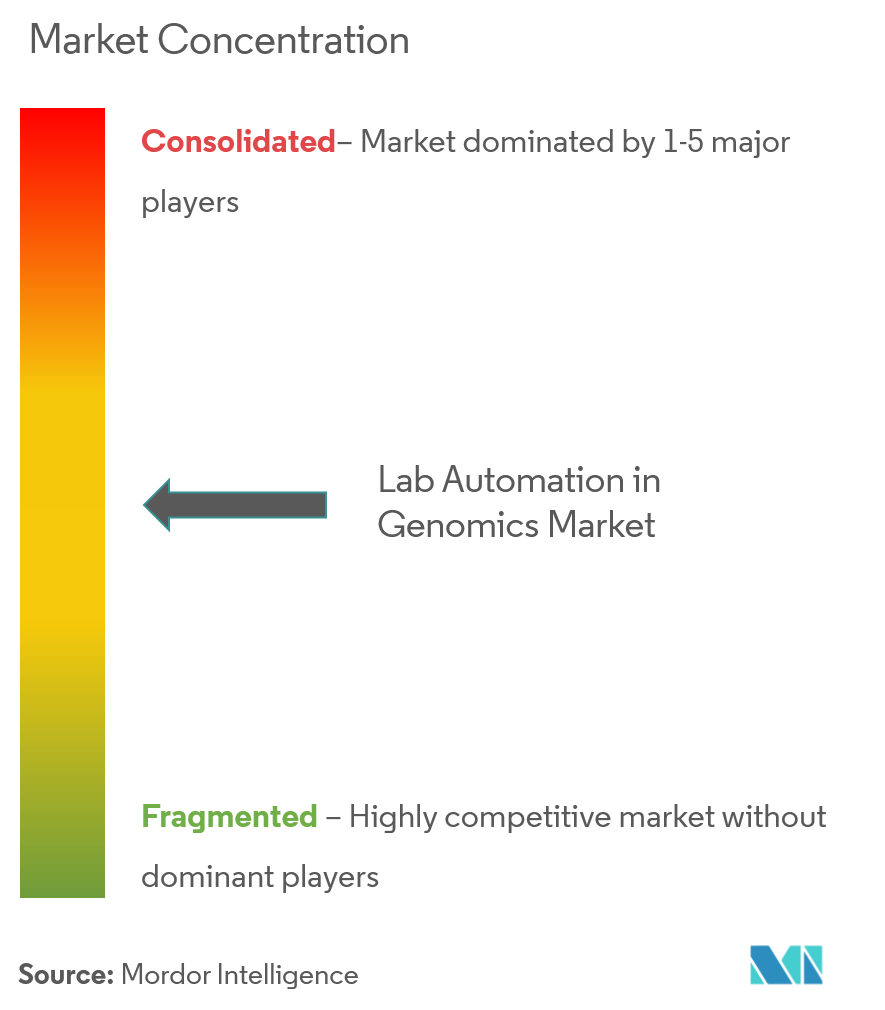Lab Automation in Genomics Market Size

| Study Period | 2019 - 2029 |
| Market Size (2024) | USD 2.12 Billion |
| Market Size (2029) | USD 3.81 Billion |
| CAGR (2024 - 2029) | 12.43 % |
| Fastest Growing Market | Asia Pacific |
| Largest Market | North America |
Major Players.webp)
*Disclaimer: Major Players sorted in no particular order |
Lab Automation in Genomics Market Analysis
The Lab Automation In Genomics Market size is estimated at USD 2.12 billion in 2024, and is expected to reach USD 3.81 billion by 2029, growing at a CAGR of 12.43% during the forecast period (2024-2029).
There has been a significant improvement in understanding genome sequencing in terms of data analytics advances that reveal unknown correlations, hidden patterns, and other insights, especially when testing data sets on a large scale. This is due to technological advancements and increasing computational capacities driving the market.
- The development of genomics, which uses the availability of whole DNA sequences for entire organisms, is due to the innovative work of a few genomics giants and the more recent next-generation sequencing technology.
- The speed, volume, and price of genome sequencing have all dramatically increased because of the development of next-generation sequence technologies. Additionally, hundreds of life science databases and programs that promote scientific study have been made possible because of advancements in bioinformatics. These databases make it simple to search, contrast, and analyze the information that is organized and kept there.
- Furthermore, significant medical advancements are occurring quickly, mostly due to recent improvements in genomic analysis. DNA sequence analysis clarifies how genetic diversity causes disease and ultimately results in novel treatments. Additionally, laboratory automation has opened space for innovative flexibility, increased throughput, and cost-effective solutions. It allows for quick handling and enables the process to be sped up without worrying about accuracy and dependability. Due to the low cost of genotyping and DNA sequencing, the expansion rate is strong.
- Genetic testing start-ups have been springing up like daisies due to improvements in DNA sequencing technology that have made it more affordable and widely available. However, the knowledge of whole genomes has made functional genomics viable, particularly interested in gene expression patterns under various situations, making it possible for genome sequencing programs to increase rapidly in breadth and speed. The most important tools, in this case, are microarrays and bioinformatics.
- Nucleic acid isolation, RNAi screening, CRISPR analysis, PCR, and gene expression analysis are just a few of the genomics applications that use automation. Laboratory automation players/vendors are developing tools to meet these application requirements. For example, Tecan Group's new "Fluent Automation Workstation" platform incorporates a variety of capabilities to simplify day-to-day laboratory automation and increase workflow productivity. During a run, the system reacts dynamically, adjusting based on actual times to maintain continuous optimal throughput, all of which are visible in real-time via an easy-to-understand Gantt chart.
- The companies are developing new products or incorporating new features in the existing products to meet the needs of the customer. For instance, in May 2023, opentrons, a lab automation solution provider, announced the launch of an Opentrons Flex robot, a liquid-handling lab robot. Flex Robot is compatible with artificial intelligence tools.
- The cost is the major concern in lab automation in the genomics market. The initial setup cost is high, so several developing countries focus on the adoption of cost-effective lab automation systems such as refurbished lab automation. Also, declining consumer spending on buying new and costly equipment due to increasing interest rates and economic downturns restrict market growth.
Lab Automation in Genomics Market Trends
Automated Liquid Handlers to Witness High Growth
- In the genomics lab, cross-contamination is a significant issue that can be prevented by employing automated systems to manage the reagents and reaction mixtures. It is thought that eliminating human intervention leads to more consistency. Numerous technological developments in the plastics molding industry have decreased the number of chemicals needed and made it easy to handle smaller volumes of liquid. These developments have made it easier to create micro- and nanoliter plates that can work with automated liquid-handling machinery.
- Industry innovators have established the standard to create automated liquid handlers. To boost process productivity, these businesses consistently invest in designing quality products. As an illustration, Agilent's adaptable and space-saving automated liquid handling systems allow for streamlined sample preparation with consistently high accuracy. While retaining repeatability, automation enables labs to run more samples and free up manual labor.
- Additionally, the quick expansion of several clinical and pre-clinical trials across the globe, mostly in the US, has made the requirement for speed in sample analysis essential. The machines operate nonstop in clinical research and require sizable personnel to maintain proper operation. Additionally, the demand for early treatments and diagnostics grows as new diseases are discovered and old ones spread quickly. This is anticipated to accelerate the adoption of automated liquid handlers by raising the rate at which clinical diagnostic applications are made.
- Automated liquid handling robots disperse and sample liquids in tubes or wells and are frequently integrated as mechanical injection modules as the front end of liquid chromatographic systems. This kind of equipment can also include automated pipetting systems and microplate washers. These essential labor-saving tools provide accurate sample preparation for various bioassays, liquid or powder weighing, sample preparation, and high throughput screening/sequencing (HTC).
- The life science industry, in terms of automated liquid handlers, automated plate handlers, and robotic arms, among others, has had the third-highest growth in industrial robots, according to the Robotic Industries Association, to fulfill the demand.

North America Occupies the Largest Market Share
- North America has been a pioneer in clinical research for years. This region is home to some of the major pharmaceutical companies, like Pfizer, Novartis, GlaxoSmithKline, J&J, and Novartis. The region also has the highest concentration of contract research organizations (CROs). Some of the significant CROs are Laboratory Corp. of America Holdings, IQVIA, Syneos Health, and Parexel International Corp.
- Owing to the presence of all the major players in the industry and stringent FDA regulations, the market is very competitive in the region. To gain an advantage over competitors, the genomics research organizations in the region are increasingly adopting robotics and automation in labs.
- The genomic industry, especially in the United States, is still in its growing phase and is expected to grow at a fast pace over the coming years. The availability of new genome sequencing technologies, well-established healthcare infrastructure, and the increasing geriatric population are significant contributing factors toward the revenue growth of the market.
- In the United States, the need to accommodate growth and the drive to boost efficiency are priming blood centers to acquire fully automated walkaway systems, either to perform types and screens or to test specimens for infectious diseases or both.
- The US genomic industry is expected to grow at a fast pace over the coming years. The availability of new genome sequencing technologies, well-established healthcare infrastructure, and the increasing geriatric population are significant contributing factors toward revenue growth of the market. Additionally, the demand for precision medicines is rising in the country.

Lab Automation in Genomics Industry Overview
Lab automation in the genomics market is moderately competitive, owing to many small and big players exporting products to many countries. The key strategies adopted by the major players are technological advancement in development, partnerships, and mergers and acquisitions. Some of the major players in the market are Thermo Fisher Scientific Inc., F. Hoffmann-La Roche Ltd, Siemens Healthineers, Danaher Corporation, PerkinElmer, and others.
In January 2023, Becton, Dickinson, and Company (BD) introduced a new lab automation solution - 'the third-generation BD Kiestra Total Lab Automation System' for microbiology laboratories. The new automated robotic track system will assist in streamlining workflow and optimizing lab space. It is used with the BD Kiestra microbiology laboratory solution that automates lab specimen processing.
In February 2023, Automata, a laboratory automation solution provider, announced a business expansion in the United States as it will likely help the United States life science industry to save lab spaces with automation. With Automata's technology, the United States life sciences industry will increase output and cut workflow times by up to 50%, increase existing lab space, and save scientists time to work on innovative research.
Lab Automation in Genomics Market Leaders
-
Thermo Fisher Scientific Inc.
-
Danaher Corporation / Beckman Coulter
-
Hudson Robotics Inc.
-
Becton, Dickinson and Company
-
Synchron Lab Automation
*Disclaimer: Major Players sorted in no particular order

Lab Automation in Genomics Market News
- June 2024: UK has introduced robotic technology to enhance genomic testing for cancer patients. This initiative stems from a collaboration between The Royal Marsden NHS Foundation Trust and Automata Technologies, a frontrunner in automating life sciences laboratories. Utilizing Automata’s LINQ platform, the automation process now encompasses sample pathways for saliva, tissue biopsies, blood, and bone marrow. The LINQ platform, described as a ‘smart’ laboratory bench, integrates and connects various equipment through advanced robotic and digital technologies.
- March 2024: Tecan introduced LabNavigator and Next-Gen Introspect, advanced tools designed to digitize lab operations, empowering researchers and technicians. Liquid biopsy acts as a vital link, connecting upstream diagnostics with genomics-driven therapies, from biomarker detection to precision medicine. Tecan’s genomics portfolio, including DreamPrep NAP workstation for nucleic acid extraction and DreamPrep NGS for sample preparation, offers fully automated, walkaway solutions. These solutions standardize high-throughput workflows, ensuring consistency and reliability.
Lab Automation in Genomics Market Report - Table of Contents
1. INTRODUCTION
- 1.1 Study Assumptions and Market Definition
- 1.2 Scope of the Study
2. RESEARCH METHODOLOGY
3. EXECUTIVE SUMMARY
4. MARKET INSIGHTS
- 4.1 Market Overview
- 4.2 Supply Chain Analysis
-
4.3 Industry Attractiveness - Porter's Five Forces Analysis
- 4.3.1 Bargaining Power of Buyers
- 4.3.2 Bargaining Power of Suppliers
- 4.3.3 Threat of New Entrants
- 4.3.4 Threat of Substitute Products
- 4.3.5 Intensity of Competitive Rivalry
- 4.4 Assessment of the COVID-19 Impact on the Industry
5. MARKET DYNAMICS
-
5.1 Market Restraints
- 5.1.1 Growing Trend of Digital Transformation for Laboratories with IoT
- 5.1.2 Effective Management of the Huge Amount of Data Generated
-
5.2 Market Challenges
- 5.2.1 Expensive Initial Setup
6. MARKET SEGMENTATION
-
6.1 By Equipment
- 6.1.1 Automated Liquid Handlers
- 6.1.2 Automated Plate Handlers
- 6.1.3 Robotic Arms
- 6.1.4 Automated Storage and Retrieval Systems (AS/RS)
- 6.1.5 Vision Systems
-
6.2 By Geography***
- 6.2.1 North America
- 6.2.2 Europe
- 6.2.3 Asia
- 6.2.4 Latin America
- 6.2.5 Middle East and Africa
7. COMPETITIVE LANDSCAPE
-
7.1 Company Profiles
- 7.1.1 Thermo Fisher Scientific Inc.
- 7.1.2 Danaher Corporation / Beckman Coulter
- 7.1.3 Hudson Robotics Inc.
- 7.1.4 Becton, Dickinson and Company
- 7.1.5 Synchron Lab Automation
- 7.1.6 Agilent Technologies Inc.
- 7.1.7 Siemens Healthineers AG
- 7.1.8 Tecan Group Ltd.
- 7.1.9 Perkinelmer Inc.
- 7.1.10 Eli Lilly and Company
- 7.1.11 F. Hoffmann-La Roche Ltd.
- *List Not Exhaustive
8. INVESTMENT ANALYSIS
9. FUTURE TRENDS
** Subject To AvailablityLab Automation in Genomics Industry Segmentation
The use of instrumentation to perform laboratory activities with minimum human involvement is known as lab automation. Lab automation is divided into three stages: pre-analytical, analytical, and post-analytical. Automated processes can be applied to all aspects of the experimental process. The scope of the study focuses on the market analysis of lab automation in genomics across the world, and market sizing encompasses the revenue generated by these products sold by various market players.
The lab automation in genomics market is segmented by equipment (automated liquid handlers, automated plate handlers, robotic arms, automated storage and retrieval systems, and vision systems) and geography (North America, Europe, Asia-Pacific, and the Rest of the World). The market sizes and forecasts are provided in terms of value (USD) for all the above segments.
| By Equipment | Automated Liquid Handlers |
| Automated Plate Handlers | |
| Robotic Arms | |
| Automated Storage and Retrieval Systems (AS/RS) | |
| Vision Systems | |
| By Geography*** | North America |
| Europe | |
| Asia | |
| Latin America | |
| Middle East and Africa |
Lab Automation in Genomics Market Research FAQs
How big is the Global Lab Automation in Genomics Market?
The Global Lab Automation in Genomics Market size is expected to reach USD 2.12 billion in 2024 and grow at a CAGR of 12.43% to reach USD 3.81 billion by 2029.
What is the current Global Lab Automation in Genomics Market size?
In 2024, the Global Lab Automation in Genomics Market size is expected to reach USD 2.12 billion.
Who are the key players in Global Lab Automation in Genomics Market?
Thermo Fisher Scientific Inc., Danaher Corporation / Beckman Coulter, Hudson Robotics Inc., Becton, Dickinson and Company and Synchron Lab Automation are the major companies operating in the Global Lab Automation in Genomics Market.
Which is the fastest growing region in Global Lab Automation in Genomics Market?
Asia Pacific is estimated to grow at the highest CAGR over the forecast period (2024-2029).
Which region has the biggest share in Global Lab Automation in Genomics Market?
In 2024, the North America accounts for the largest market share in Global Lab Automation in Genomics Market.
What years does this Global Lab Automation in Genomics Market cover, and what was the market size in 2023?
In 2023, the Global Lab Automation in Genomics Market size was estimated at USD 1.86 billion. The report covers the Global Lab Automation in Genomics Market historical market size for years: 2019, 2020, 2021, 2022 and 2023. The report also forecasts the Global Lab Automation in Genomics Market size for years: 2024, 2025, 2026, 2027, 2028 and 2029.
Lab Automation in Genomics Industry Report
Statistics for the 2024 Lab Automation in Genomics market share, size and revenue growth rate, created by Mordor Intelligence™ Industry Reports. Lab Automation in Genomics analysis includes a market forecast outlook 2029 and historical overview. Get a sample of this industry analysis as a free report PDF download.



